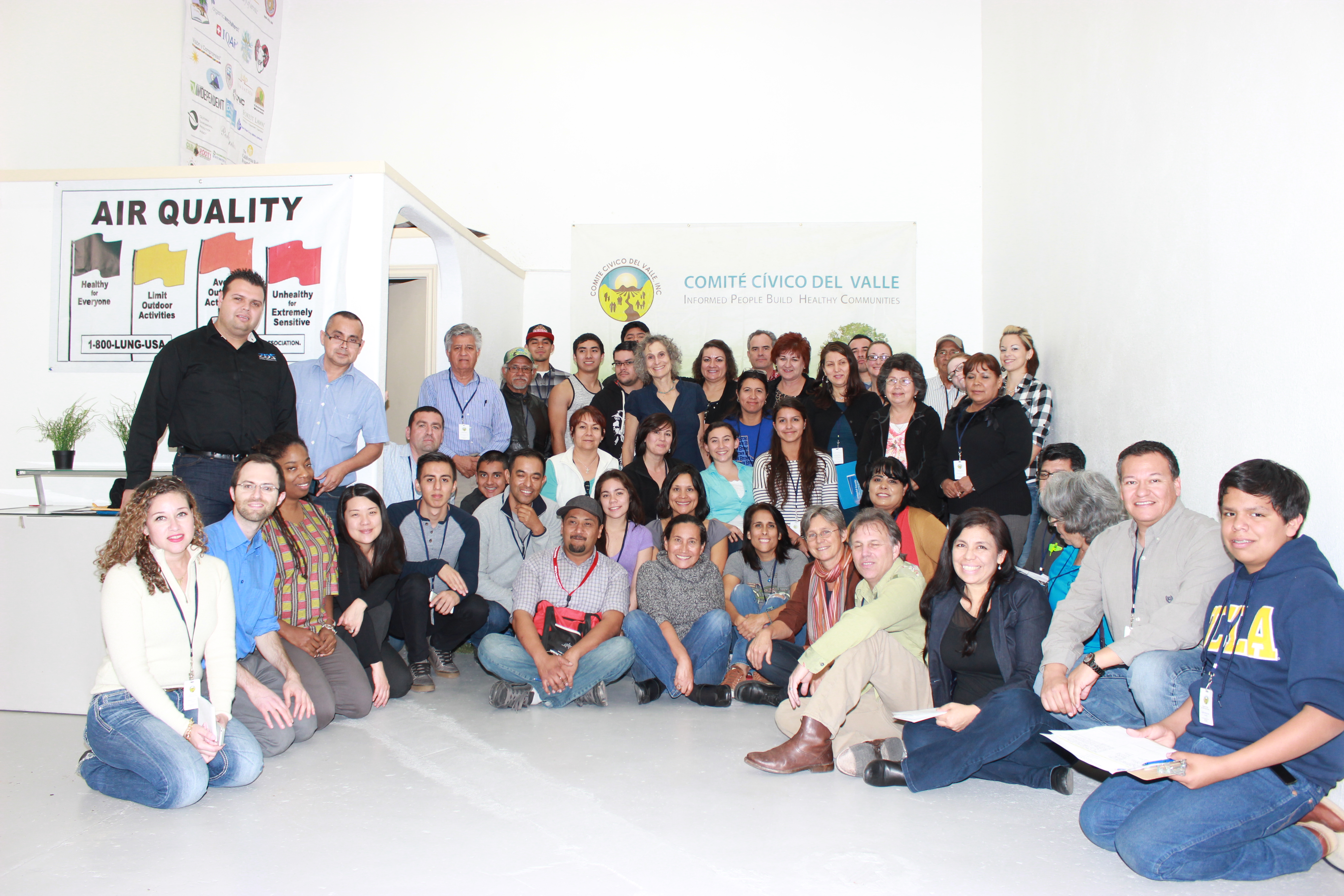Project Overview

These community participants and project staff completed two days of training and data collection.
(Photo courtesy of Paul English)
Air pollution is a major concern for residents of Imperial County, California. The county not only experiences consistently high levels of air pollution, but also has one of the state’s highest rates of asthma hospitalization and emergency room visits for school-aged children.
A collaboration involving a community organization, a state agency, and academic institutions, has created a community-owned and maintained network of low-cost air monitors in Imperial County. Communities will use data from these monitors to develop strategies to improve public health.
Community involvement includes:
- Project design and implementation
- Siting and maintaining air monitors
- Data collection
- Interpreting results
- Communicating findings to the community and other stakeholders
Background

Agricultural burning is one source of air pollution in Imperial County.
(Photo courtesy of Paul English)
Air pollution in Imperial County comes from agricultural burns, diesel fumes, and other sources such as automobile exhaust. Spanning over 4,000 square miles, the county contains a limited number of regulatory air pollution monitors operated by the Imperial County Air Pollution Control District and the California Air Resources Board. These regulatory monitors provide minimal information about neighborhood-level air pollution in the primarily Latino communities, many of which have high rates of unemployment and poverty.
Additional monitors were needed to identify “hot spots” with particularly high levels of pollution, which can be used to develop policies and public health actions that lessen exposure to air pollution and improve health. To solve this problem, the California Environmental Health Tracking Program, the community organization Comité Cívico del Valle, and the University of Washington came together to develop an air monitoring network that could make real-time, community-level air quality data available to enable residents to take immediate action to reduce exposures.

Students and school staff assist in the installation of an air monitor on the rooftop of Brawley Union High School.
(Photo courtesy of Paul English)
The project builds on a long-standing collaboration between Comité Cívico del Valle and the California Environmental Health Tracking Program, which is a collaboration of the California Department of Public Health and the Public Health Institute. These partners have worked together for more than a decade on projects that identify and address issues related to air contaminants and asthma in the Imperial Valley. Research consultants from George Washington University and the University of California Los Angeles were also involved in the project.
Community Involvement
For the current project, Imperial County community participants from 11 neighborhoods collected data to inform the placement of 40 low-cost, portable air monitors. Air pollution data collected by the air monitors is currently being analyzed. Comité Cívico del Valle staff are involved in all aspects of the project, including installation and maintenance of the monitors, which will remain in the community after the project.
A Community Steering Committee of 15 community members meets regularly with the project team to guide project activities. Community participants bring valuable knowledge, access, relationships, capacity, and resources to the project. They also offer input on disseminating data in a way that is accessible, understandable, useful, and accurate. In addition to building on the trust and relationships established during prior projects, the partnership encompasses a commitment to community engagement and scientific rigor while ensuring shared decision-making responsibilities.
Outcomes
Real-time air pollution information. Staff from Comité Cívico del Valle have completed installation of all 40 low-cost air monitors. Real-time particulate matter (PM) air pollution data from the monitors is available on the IVAN website, a platform previously developed by the community to report violations involving toxic substances.
The IVAN Air Monitoring portion of the website provides air quality data in a map or list form and lets users sign up for alerts. To inform the design of the IVAN Air Monitoring website and the health messaging displayed there, the California Environmental Health Tracking Program conducted needs assessments and focus groups with residents and members of the Community Steering Committee.
The project collaborators are also conducting analysis to estimate PM levels for areas of the county without air monitors.
Taking action. Project collaborators continue to work on analyzing the data from the monitors. This information will be used to identify “hot spots” and to show how wind direction and transport of the pollutants affects PM levels. Communities can use the results of the analysis to decide how to convert the research findings to public health action. For example, they might use the data to inform policies that lower pollution levels, develop new routes to school that travel through less-polluted areas, or suggest that residents stay indoors on days with particularly high levels of pollution. In addition, schools with monitors are already using the data in real-time to determine when the air quality is poor enough that schoolchildren should remain indoors.
Expanding reach. The project partners plan to share their model with other communities by creating a manual and hosting a workshop on how to develop a community air network. They will also launch a youth environmental health academy in Imperial County to involve high school students in conducting outreach and education about the air monitoring network.
Ensuring quality. The project partners met with air monitoring staff at the local air district, the California Air Resources Board, and the U.S. Environmental Protection Agency to understand and address expressed concerns about the reliability and accuracy of the low-cost air monitoring network as well as the messaging.
A key outcome of these meetings was that the project team could collocate the project monitors with regulatory monitors to validate them and demonstrate that the project monitors performed well. The team also established a technical advisory group with regulatory agency staff to get input and provide updates on technical activities related to the project. Furthermore, the partners developed clear messaging for the IVAN website to explain limitations of the data and to provide guidance to help community residents interpret and use the air monitoring information.
Ensuring sustainability. From the beginning of the project, the collaborators wanted to make sure that the air monitor network remained community-owned and -operated even after funding ended. With this in mind, staff from Comité Cívico del Valle were trained in programming the transfer of data from the monitors and learned how to repair software and hardware problems. Project partners are also exploring ways that state agencies might help with long-term maintenance of the network.
Contact



